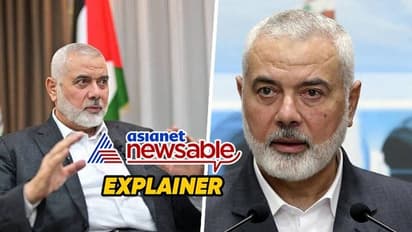Ismail Haniyeh assassinated: What Hamas chief's killing means for stability of region amidst Gaza war?

Synopsis
Hamas leader Ismail Haniyeh was reportedly killed in Tehran on July 31. Details are unclear, with Hamas accusing Israel of a “treacherous raid.” The IRGC confirmed Haniyeh's death but did not assign blame. The incident follows an Israeli drone strike in Beirut that killed a Hezbollah commander. Haniyeh, a key Hamas figure, was known for his role in the group's radical activities and diplomatic efforts.
Hamas announced in a statement early on Wednesday (July 31), that their top political leader, Ismail Haniyeh, was killed in Tehran. The details of Haniyeh’s death are not yet clear and no one has taken responsibility. Hamas accused Israel of a “treacherous raid” on Haniyeh’s home in Tehran.
The Israeli media reported that Prime Minister Benjamin Netanyahu told his Cabinet ministers not to comment on the killing. Before Hamas’s statement, Iran’s Islamic Revolutionary Guard Corps (IRGC) announced that Haniyeh—who was in Tehran for Iranian President Masoud Pezeshkian’s inauguration—and his bodyguard were killed at his home in Tehran. The IRGC said an investigation was on.
Who was Ismail Haniyeh, the Hamas leader and ex-PM killed in Tehran?
According to the New York Times citing two Iranian officials, Iran’s Supreme National Security Council met at the home of supreme leader Ali Khamenei on Wednesday. This council, which reports directly to Khamenei, takes the country’s top strategic decisions. Haniyeh had met both Pezeshkian and Khamenei on Tuesday.
The killing happened less than a day after an Israeli drone strike in the southern suburbs of Beirut, Lebanon’s capital, targeting a Hezbollah commander. The Israeli military stated that the strike had killed Fuad Shukr, who led Hezbollah’s military operations and precision missile project.
Who was Haniyeh?
Haniyeh spent most of his time in exile in Qatar as the head of Hamas’s political bureau, serving as a key link between Hamas and Iran. In April, an Israeli airstrike killed three of his sons in the Gaza Strip. Haniyeh was involved in Hamas’s radical activities in the late-1980s and was arrested several times by Israelis. After being released from jail in 1992, Israel exiled Haniyeh and several other Hamas leaders to a no-man’s land in southern Lebanon.
His swift rise within Hamas started in 1997 when he was chosen to lead the office of the movement’s spiritual leader, Sheikh Yassin. In 2006, during the Palestinian Authority’s parliamentary elections in West Bank and Gaza, Haniyeh served as Hamas’s parliamentary leader. The Islamist group won a surprising victory in the election and Haniyeh became Prime Minister of Palestine.
However, tensions arose between Fatah, President Mahmoud Abbas’s party and Hamas, leading Abbas to dissolve the Hamas government in 2007. Haniyeh rejected this decision and continued to govern from Gaza, while Fatah controlled West Bank. In 2017, Haniyeh stepped down as Hamas leader in Gaza, allowing Yahya Sinwar to take over. That same year, Haniyeh became the chairman of Hamas’s ‘political bureau’, succeeding Khaled Meshal.
Despite his strong public statements, Arab diplomats and officials saw him as more pragmatic compared to the hardliners in Gaza, where Hamas’s military wing planned the October 7 attack. While warning Israel’s military that they would “drown in the sands of Gaza”, he and his predecessor, Khaled Meshaal, travelled around the region to discuss a Qatari-brokered ceasefire deal with Israel. This deal aimed to exchange hostages for Palestinians in Israeli jails and secure more aid for Gaza.
Haniyeh, a Sunni Muslim, played a key role in strengthening Hamas’s military by fostering ties with Shi’ite Muslim Iran, which openly supports the group. During the 10 years in which Haniyeh led Hamas in Gaza, Israel accused his leadership of redirecting humanitarian aid to Hamas’s military wing. Hamas has denied these accusations.
When Haniyeh left Gaza in 2017, Yahya Sinwar, a hardliner who had spent over 20 years in Israeli prisons, succeeded him. As a young man, Haniyeh was actively involved in student activism at the Islamic University in Gaza City. He joined Hamas when it was formed during the First Palestinian Intifada in 1987. He was arrested and briefly deported.
Haniyeh’s Early Years
Haniyeh became a protégé of Hamas’s founder, Sheikh Ahmad Yassin, who, like Haniyeh’s family, was a refugee from Al-Jura village, near Ashkelon. By 2003, Haniyeh was a trusted aide to Yassin and was photographed in Yassin’s Gaza home holding a phone to the almost completely paralysed Hamas founder’s ear so he could participate in a conversation. Yassin was killed by Israel in 2004.
'Mossad rocks': Social media erupts after Hamas chief Ismail Haniyeh assassinated in Tehran, memes explode
Haniyeh was an early supporter of Hamas entering politics. In 1994, he said forming a political party would make Hamas capable of handling emerging developments. Although the Hamas leadership at first objected to the idea, it was later approved and Haniyeh became Palestinian Prime Minister after they won the parliamentary elections in 2006. This happened a year after Israel’s withdrawal from Gaza. The group assumed control of Gaza in 2007.
In 2012, when Reuters reporters asked if Hamas had given up armed struggle, Haniyeh denied strongly and said resistance would continue in all forms—popular, political, diplomatic and military.
(The author of this article is a Defence, Aerospace & Political Analyst based in Bengaluru. He is also the Director of ADD Engineering Components, India, Pvt. Ltd, a subsidiary of ADD Engineering GmbH, Germany. You can reach him at: girishlinganna@gmail.com)
Check the Breaking News Today and Latest News from across India and around the world. Stay updated with the latest World News and global developments from politics to economy and current affairs. Get in-depth coverage of China News, Europe News, Pakistan News, and South Asia News, along with top headlines from the UK and US. Follow expert analysis, international trends, and breaking updates from around the globe. Download the Asianet News Official App from the Android Play Store and iPhone App Store for accurate and timely news updates anytime, anywhere.